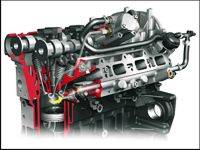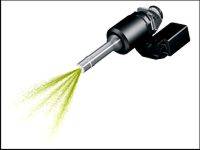Together, the supercharger and turbocharger create a power source that's not only extremely potent due to its high boost, but one that's incredibly
 |
| Together, the supercharger and turbocharger create a power source that's not only extremely potent due to its high boost, but one that's incredibly responsive as well. (Photo: Volkswagen Canada) |
responsive as well. At just above idle, the supercharger produces 26 psi (1.8 bar) of boost - more than most turbocharged vehicles are producing at maximum boost! VW claims that power is always on tap, with a minimum of 148 lb-ft (200 Nm) of torque available to the driver between just 1,250 rpm and 6000 rpm. The automatic boost pressure control system is responsible for deciding when the switchover from supercharger to turbocharger should take place, and observes engine rpm, and which gear the vehicle is in. With the supercharger providing boost and keeping the engine spinning fast enough, the usual switchover to turbo occurs before 3,500 rpm, a speed where the turbo is capable of sustaining maximum acceleration without any pause or delay.
When working together at a boost ratio of approximately 1.53, the two forced aspiration units create a total boost of about 36.3 psi (2.5 bar) at 1500
 |
| Equally amazing is the total output; the two forced aspirators give the 1.4-litre engine a total of 170 horses, making for an unparalleled specific output of 121-horsepower per litre. (Photo: Volkswagen Canada) |
rpm, an astonishing figure considering there is no turbo lag whatsoever. Equally amazing is the total output; the two forced aspirators give the 1.4-litre engine a total of 170 horses, making for an unparalleled specific output of 121-horsepower per litre. VW rates the tiny 1.4-litre engine comparable to that of a naturally aspirated 2.3-liter unit - 177 lb-ft (240 Nm) between 1750 - 4500 rpm. If this wasn't a sweet enough deal, fuel consumption is 20 percent less, using just 7.2 L/100 km (39.2 mpg) in the city and 5.9 L/100 km (47.9 mpg) on the highway. Carbon dioxide (CO2) emissions, the reduction of which was a critical element of the program, are just 140 g/km. Later in 2006, Volkswagen will introduce a less powerful version of this motor with 140-horsepower and 162 lb-ft (220 Nm) of torque for global (non-North American) market Golfs, Jettas and Tourans (VW's Euro minivan).




